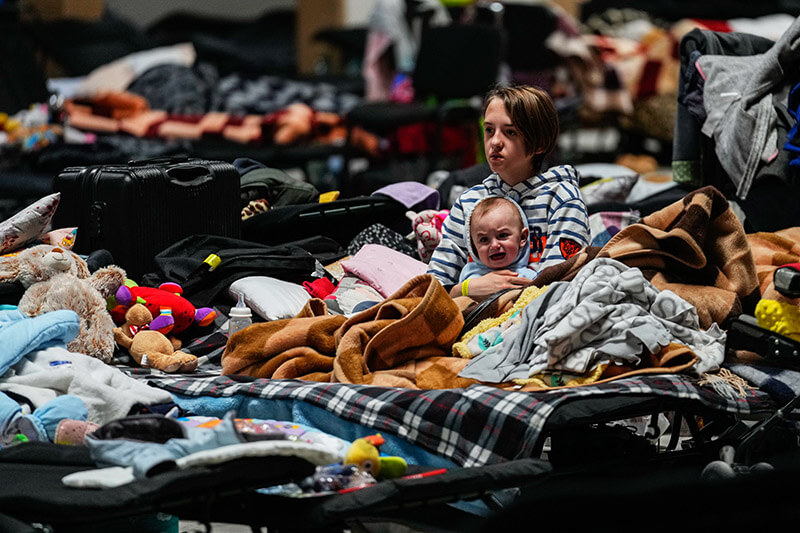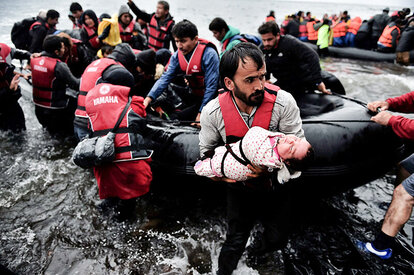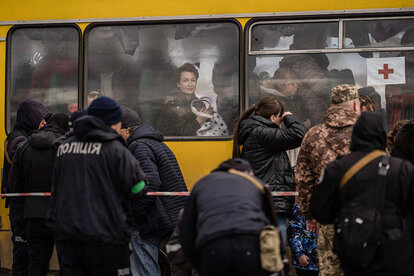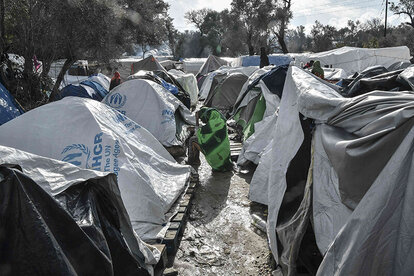War in Europe
Wars and migration

Refugee center in Nadarzyn, near Warsaw, Poland
© PHOTO/APAs is well known, wars (along with poverty, natural disasters and persecution) are one of the reasons at the root of migratory movements, of significant movements of people. Although political debates at the European level often tend to focus on migration for economic reasons, periodically (and unfortunately) various armed conflicts, more or less close to home, have a direct impact on migratory flows to our continent.
In the memories of European citizens, before the conflict that has been raging in Ukraine since February this year, there is undoubtedly the war in Syria, which, although it began in 2011, did not affect Europe in a significant way from a migratory point of view until the summer of 2015. However, in addition to these conflicts of particular relevance to Europe, in 2018 the UN recorded refugees fleeing armed conflict from South Sudan, Yemen, Central African Republic, Nigeria, Burundi, Somalia, Ethiopia, Sudan and the Democratic Republic of Congo.

Refugees and migrants arriving on the Greek island of Lesbos after crossing the Aegean Sea from Turkey.
© PHOTO/AFPAt the time of writing (mid-April 2022), the latest update from the United Nations High Commissioner for Refugees (UNHCR) indicates that more than 4.7 million people have fled Ukraine since the Russian attacks began on 24 February. Specifically, UNHCR puts the number of refugees at 4,736,471 (data from Thursday 14 April), which is almost 80,000 more than the previous day's count. This number of people displaced by armed conflict is already the highest since the Second World War. 90% of those fleeing are women and children, as men of legal age are obliged to remain in their country to help defend it.
The International Organisation for Migration (IOM) estimates that there are 7.1 million internally displaced persons (IDPs) in Ukraine, i.e. citizens who have not left the country but have been forced to leave their homes because of the war. In total, therefore, almost 12 million people have had to leave their homes, either by crossing borders to reach one of the neighbouring countries or by moving to a safer part of Ukraine. To better contextualise these figures, it should be remembered that, before the war began, the population of Ukraine (in the territories controlled by the government in Kiev, i.e. excluding Crimea and the areas in the east of the country controlled by pro-Russian separatists since 2014) was just over 37 million people. In other words, the war with Russia has led to the displacement (internal or external) of approximately 31% of Ukrainian citizens.

An internally displaced woman looks out the window of a bus after arriving from Mariupol at a center for refugees fleeing Russian attacks, in Zaporizhzhia, Ukraine.
© PHOTO/APUNHCR also provides us with the distribution of refugees in other countries: Poland is by far the state hosting the highest number of refugees: 2,694,090 have entered the country since 24 February. In second place is Romania, which has already taken in 716,797 people. In Russia, the number of refugees stood at 471,014 on 13 April (UNHCR noted that between 18 and 23 February, just before the start of the war, 105,000 people moved to Russia from the pro-Russian separatist territories of Donetsk and Lugansk). Hungary has received 440,387 Ukrainians. Moldova, with 417,650 refugees, is the fifth country in terms of the number of arrivals (the figure is significant, as Moldova has 2.6 million inhabitants, and is one of the poorest countries in Europe). Finally, Slovakia has received 326,244 refugees and Belarus 22,428.

Vial refugee camp, on the Greek island of Chios
© PHOTO/AFPThe strategic and political importance of Russia's aggression against Ukraine for Europe surely explains the marked differences between the reception given to Syrian refugees at the time and that now given to Ukrainians. Perhaps one fact can sum up this change of consideration like no other: Poland and Hungary, two countries belonging to the Visegrad Group, refused (together with the Czech Republic) to honour the agreement reached by the EU in September 2015 for the distribution of 160,000 Syrian refugees arriving in Greece and Italy. In the current situation, these two countries, bordering Ukraine, are nevertheless, as we have just seen, among those that have taken in the most Ukrainian refugees since the beginning of the war to date. The consideration of Ukraine as part of Europe, the fact that Ukrainians have been economic migrants in different EU countries over the last decade, seem to contribute to Europeans conceptualising Ukrainians as equals, and feeling the aggression towards them as (almost) their own, without the need for a symbolic element (as, in September 2015, the image of Aylan Kurdi's corpse on a Turkish beach) to trigger solidarity.
Luis Guerra, PhD in Philology, is an associate researcher of the INMIGRA3-CM project, financed by the Community of Madrid and the European Social Fund.
